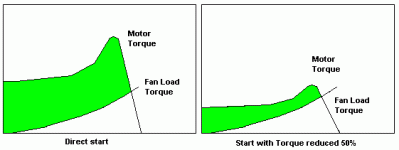Sliver
Member
We have several 200hp dust collector fans that start across-the-line.
They start usually about twice a week and run almost continously.
They have dampers for control that are shut when starting
Typical startup times are in the 60 second range (high inertia load)When the air temp drops air becomes denser increasing load and starting time. This is when we have troubles starting without tripping overloads. We have started changing out the thermal o/l with electronic/programmable to allow starts but protect motor when running.
Across-the-line makes drive belts squeal, so mechanical is tempted to tighten belts which has caused a few motor shaft failures.
If I could wave a magic wand we would install softstarts on the works.
Brian.
They start usually about twice a week and run almost continously.
They have dampers for control that are shut when starting
Typical startup times are in the 60 second range (high inertia load)When the air temp drops air becomes denser increasing load and starting time. This is when we have troubles starting without tripping overloads. We have started changing out the thermal o/l with electronic/programmable to allow starts but protect motor when running.
Across-the-line makes drive belts squeal, so mechanical is tempted to tighten belts which has caused a few motor shaft failures.
If I could wave a magic wand we would install softstarts on the works.
Brian.






